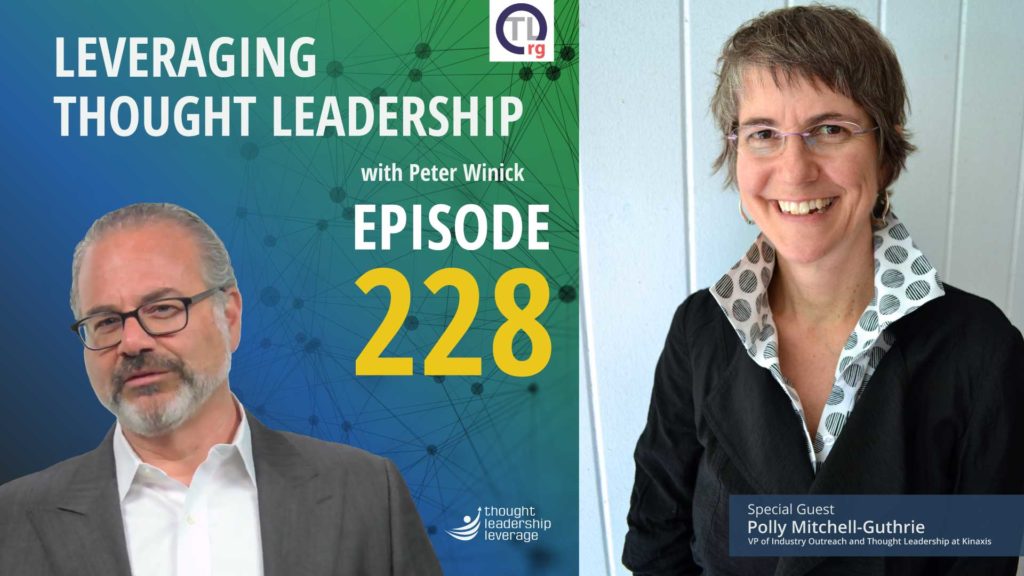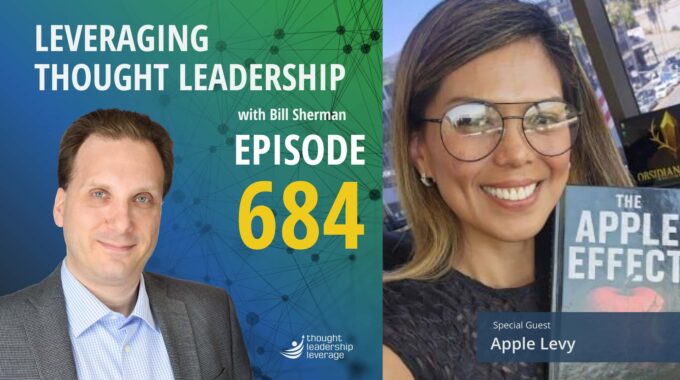A field-tested framework for leaders who want better margins, cleaner operations, and a stronger culture…
Staying Connected as a Thought Leader | Polly C Mitchell-Guthrie
Getting Connected and Staying Connected in a Diverse Thought Leadership World.
An interview with Polly Mitchell-Guthrie about thought leadership strategy in speaking and presentations, and how to measure thought leadership success against audience interest.
We interviewed Polly Mitchell-Guthrie, the VP of Industry Outreach and Thought Leadership at Kinaxis. Previously, she was Director of Analytical Consulting Services at the University of North Carolina Health Care System, and founded the third chapter of Women in Machine Learning and Data Science (now more than 90 chapters worldwide). She’s here to talk to us about organizational thought leadership at Kinaxis, how having an “in-house guru” helps both the organization and the customer, and the “four-one-one” of content for organizational thought leadership.
Also, Polly talks to us about how Kinaxis is earning trust through credible standalone Thought Leader content that comes from not only within the company but from their peers as well. She speaks about the difficult task of measuring the success of Thought Leadership and how Kinaxis uses a promoter score as part of their metric. Plus, Polly gives some great insight into what anyone looking to bring Thought Leadership to their organization will need and what they should be prepared to do.
Four Key Takeaways from the Interview:
- The definition of organizational thought leadership at Kinaxis.
- How organizational thought leadership is about building trust, contributing to a conversation, and engaging with the broader ecosystem of thought leaders.
- The “four-one-one” of organizational thought leadership: Four pieces of content about the business issues, one about the company, and one that’s fun, quirky, or curious.
- What an up and coming Thought Leader needs to be thinking about before jumping into the role in their organization.
If you enjoyed this podcast on organizational thought leadership and staying connected, check out OrgTL.com and join the LinkedIn group and the discussion. If you need help with any aspect of your thought leadership, contact Thought Leadership Leverage.
Transcript:
Peter Welcome, welcome, welcome. This is Peter Winick. I’m the founder and CEO at Thought Leadership Leverage and you’re joining us on the podcast today, which is Leveraging Thought Leadership. This is one of our episodes for the organizational thought leader. So this a little bit different than what we normally do. We’re doing a series of these as a result of our starting to get an understanding of what companies and organizations are doing with thought leadership. So with that sort of disclaimer, I’d like to welcome Polly Mitchell Guthrie. Polly is the V.P. of industry outreach and thought leadership at Kinaxis, the leader and empowering people to make confident supply chain decisions. Previously, she served in roles as director of analytic consulting services at the University of North Carolina Health Care System, senior manager of the Advanced Analytics Customer Liaison Group and SAS Research and Development Division, and director of the SAS Global Academic Program. She has an MBA from University, North Carolina, Chapel Hill and a B.A. in Political Science, as well as a Morehead scholar and many other accomplishments. But I’d rather get right into it and just chat. So how are you today, Polly?
Polly C. Mitchell-Guthrie I’m doing well. All things considered.
Peter Thank you. Great. So in your role at Kinaxis, which is a technology company focused on supply chain and by the way, thank you supply chain and under appreciated part of our universe. That is very much appreciated these days. So let me start by asking you. So let’s just start baseline here. So what is your or the organization’s definition of thought leadership?
Polly C. Mitchell-Guthrie So our definition of thought, leadership, we thought about this a lot. Our definition is that thought leadership is all about earning trust through credible standalone content that speaks peer-to-peer. And so what I mean by that is trust is all clearly about saying we’re not just trying to sell a product. Of course, at the end of the day, we are a software company. We do we are in the business of generating revenue that way. But we want to show that we’re credible. We have a vision, we have innovation. We want to share that with the world. We have a position, we have a value proposition about the unique ways we address supply. We also wanted to be standalone content. And what I mean by that is, as an example, I’m part of the Office of Strategy. Chief Strategy Officer several years ago read a white paper from another company on a foundational topic in supply chain that became the foundation for her of her understanding of that topic. She didn’t end up buying that product. She bought other things from the company. So it enhanced her trust in that company. But when I say stand alone, I mean that for her it was valuable to read that white paper because it explained the concept, even though she didn’t end up buying the product. And then speaking peer-to-peer for us, that’s a critical part. It’s all about out the fact that we want to illustrate that we have empathy with our customers. We are practitioners in thought leadership who have walked a mile in the shoes of other practitioners, meaning we are people who have led analytics teams, led supply chain teams, and we know what it’s like where we’ve been in their shoes.
Peter So what I want to unpack the trust piece, because that’s fascinating to me because. I don’t say that people don’t trust companies, but right marketing we all know, has a function. Marketing function is to support sales and sales as a function is to sell things, right. So here anything that typically comes out of a marketing function, be that in the B2B world, be that the B2C world, the recipients of that have to take it with a grain of salt, but a level of skepticism, meaning there’s some underlying agenda. Right. Jaguar doesn’t tell me how great of a car they have so that I can go buy a BMW. Right. There’s a motive. I think the trust piece is really interesting if you’re putting out pure, unadulterated content. Right. And I love the peer to peer piece. You become the trusted advisor, which is the ultimate place for any individual organization to be with their clients. And.
Polly C. Mitchell-Guthrie Right.
Peter And by not selling. I would argue that you probably sell more. So in the case of your colleague that learned something from that white paper, bought other things, but has a tremendous amount of trust for that organization. It would be interesting to sort of measure backwards to say as a result of the amazing thought leadership at that company put out. Did she want to be responsible? A billion dollars worth of purchases. You know, a year later, three years later, five years.
Polly C. Mitchell-Guthrie Right. Right. And that’s a trust for us, credibility. It’s all about the fact that. And in fact, we’re not part of marketing. My team is part of the Office of Strategy, which reports directly to the CEO. So we’re not marketing about sales. We’re not any other function.
Peter And so can I pause you there for a minute? Because. So the fact that you’re you’ve got a moat around you that you’re sitting in the strategy side. Most folks on the professional side of thought leadership at the organizational level tend to sit in product, tend to sit in marketing, and not that that’s bad. But does that take some of the pressure off of you? Being that you’re on the strategy side of the house, you have to deal sort of with the marketing stuff.
Polly C. Mitchell-Guthrie I mean, the way I’d put it is that in our in our mind, strategy is thought. Leadership is ultimately part of strategy in that what’s our long term view of where we’re going as an organization? So it’s not what are we selling today? What are we building today? What’s our immediate roadmap? It’s about what are the. You know, my sometimes my informal definition when I’ve been hiring is to say that I want to hire people who would like to think and write and speak about the business issues driving supply chain. So that’s what’s happening today. What’s happening tomorrow? What’s happening in the future and how does that inform our strategy? And also for us, an important thing about leadership is it’s by directional. So we have ideas we want to put out there and we’re trying to certainly influence the way the topic is view. But we also want to hear. So we talk to customers and prospects and analysts and other thought leaders because we want to hear back the reaction to our idea. So it needs to be engaged with the ideas and not just we know all because we certainly don’t. And I guess another thing I’d say right now about that trust factor is that for us, it’s also rooted in a sense of responsibility. And now more than ever, ever, as you point out. Supply chain is making headlines in ways that your average consumer has not thought about. Ever thought about supply chain?
Peter Yeah. We never appreciated you when there was always toilet paper on the shelf.
Polly C. Mitchell-Guthrie People think about it now. People understand the value of it to all of us. And so part of the responsibility we feel in general is that. For example, in these days, we have to think about what is the supply chain of the future going to look like? How is it going to change? We all know that that sole sourcing from China is it shows the ability and supply chain. So there are risks in that. Some of the fundamental things about companies like Amazon that have given us high expectations about getting things to us immediately, you know, that’s had supply dates and build around those expectations. So I don’t want to take us down as a plot. Sure. But my point is that our role is to think about what’s that going to look like differently in the future and how do we help not only our customers, our prospects, but the broader ecosystem, that responsibility to say we want to think for the world at large in a sense about what’s our contribution to the thinking about supply chains and they can function. And so I thought leadership is about building trust in the sense that we’re trying to contribute to a covers part of and contribute to a conversation.
Peter So I want to touch on. Yeah. So I want to touch on. The under the theme of trust you mentioned is bi directional piece, which means that you’re you know, you’re not just putting work out into the universe, but you’re talking to all these other constituents. And I think that in and of itself would build trust because of all I heard from Company X is SVP of Company X wrote an article, SVP of Company X is speaking. OK, I may that may build trust. But when you are curating and putting together a plethora of thought leadership and not every quote or not every contributor is getting their paycheck from the organization. That’s interesting. Right.
Polly C. Mitchell-Guthrie Absolutely.
Peter So that’s the probability that the receiver’s going to go. Well, this is closer to journalism, right, than it is marketing, which is really the goal.
Polly C. Mitchell-Guthrie Right. So one other way I have been thinking about this is based on an article or a book I read by a Harvard Business School professor, Ron Heifetz many years ago where he talked about the concept of the balcony in the dance floor as a mode for leadership. And this is certainly also how we think about thought leadership. So the people, especially today, the people running supply chains, are running full bore, trying to figure out how do they just keep their supply chains right now, given the sourcing and challenges, issues when you’re right there, down there on the dance floor, it can be harder to have perspective. And so customers, customers and prospects on the market look to us to say you spend all your day talking to all kinds of different companies. You learn from them. Help us learn from what you have learned. That’s where the conversation comes that we can see that we have the benefit of being able to be on the balcony. As I said, we get to the end of the dance floor by talking to people and we get practitioners. We know what it’s like ourselves. But being on that balcony gives us a chance to have that broader view, to let us synthesize what we’ve learned, contextualize it and share those learnings back. So it always has to be bi-directional. We can’t stay on the balcony. You have to work with the balcony and the dance floor. But that’s where it’s both a conversation with individuals and companies in the market, as well as a thought process of synthesizing what we’ve learned.
Peter Got it. So in your world, in your role. How do you know every organization that makes investments in a function has to say, well, that has to serve a purpose and have some sort of aura? Why some areas that’s easy, some it’s not. So we’ve seen over the last 20 plus years the challenges that brand folks and marketing folks and training people and on and on and on. Everybody has to be more accountable. Some to the click level. Right. So we know customer acquisition cost to the level of decimal. How do you with the organization, look at the investments that you make in thought leadership and put some metrics on it or determine success or say, yeah, that’s a good investment. We should do. We should do more of that next year.
Polly C. Mitchell-Guthrie Fair question. And I’ll tell you, our answer is evolving. So this is a new function for us. I’ve been on the road less than a year. I’ve just hired my first full time and I have other functions and editors never thought leadership, although that is the core of what I do. The biggest part of what I do. But I’ve just hired my first full time industry thought leader who started that last month. So this is definitely a very new cement. Yes. Well, I hope I’ve been doing stuff in it and our organization has been doing things and I will say about it. One other thing I wanted certain there is to echo something you said earlier is it’s natural thought. Leadership for us is not just about what we write and speak and contribute, but engaging with a broader ecosystem of thought leaders and so on. Right now, for example, again, being topical, I’m dealing with a number of thought leaders who are experts in areas around enterprise risk management in supply chains, and those are really relevant for the market today, trying to look at how we can be in conversation with them and elevate those thoughts for the world as part of that responsibility. But back to the measurement piece. So right now we have mainly what I’d call an input metric. You know, we can measure how many pieces of thought leadership we contribute, whether it be that we write or do a thought podcast or bring somebody else to writer speaker.
Peter So it’s in essence, volume of widgets or something. Right. So last quarter we did X number of podcasts. Whatever the stuff is. So that would be one measurement. And then what about the engagement of the pieces that you’re putting up? Is that another metric that you’re looking at?
Polly C. Mitchell-Guthrie That’s what we’re looking at. So right now, we’re still evolving how, for example, our marketing organization uses the content we produce to make it a call to action, you know, classic marketing terms that we definitely have that kind of thing. But what I’d say at a higher level that we’re looking at is, is the notion of influence and how would we measure that influence. And so clicks is one measure of influence. But here’s an example that I thought was interesting to me. So I’m very active. One other key part I see about thought leadership is through social media. For me the primary form there is LinkedIn. So I post, you know what LinkedIn would call a microblog almost, almost every day. And it’s a mixture of things about supply chain analytics, which is machine learning, which is where I have strong background and then leadership in a time of crisis, things like that. What’s interesting to me in terms of an I follow, of course, the views that I have at church, I find it surprisingly unpredictable which things generate higher engagement. One thing that interested me, as opposed to something about a tracking trajectory for the pandemic and one person and it was a supply chain person commented that they appreciated 10 axis sharing that. And so what was interesting to me is that they attribute it to the company, not to me as a person, even though it was off my personal LinkedIn profile. So it’s that suggested to me that at least that one reader, if not more than one reason, to see me as a as some other voice about these things.
Peter Yes, yeah.
Polly C. Mitchell-Guthrie I’ve always had a company, even though part of my example of trust is that I’d say I’ve tried to follow roughly the four one one rule. Four pieces of content are about the business issues I’m writing or paying attention to one about the company and one that’s just more fun or quirky or curious. Yes, I’m not heavily promoting our company every day. That’s a minimal part of what I do. I’m trying to talk about the broad issues. You know, how do you lead in a time of crisis? What is disruption being for a supply chain? What’s machine learning impact on the supply chain?
Peter And I like that four one one, because it could be for some subset of the folks that are following you, the quirkiness. They might not articulate. It is one of the factors. Why? Why do you know what I follow? She puts out these really every now and then there’s something that gets me to scratch my head and go, that’s interesting. And then, you know, you sort of maybe have to eat your vegetables to get the desserts. So but whatever it is, I love that. I mean, I think the point I’m trying to make there is sometimes we think when we’re putting our thought leadership on behalf of a company that it’s going to be so I’m in my corporate mode now and it’s going to be dry and it’s going to be specific. And you could add a little seasoning to it. You could have a little sentence, right. You could add you don’t wanna get silly. Right. But you can. You know who’s reading it? Humans are reading. What do you mean? They want to crack a smile. They want to think differently.
Polly C. Mitchell-Guthrie But again, back to the influence thing. So what I would say is that the reason I brought up social media is that it’s a little more trackable. I can see where what generates engagement, what doesn’t, what, where, where do I get comments, where do I not? And that’s something I pay attention to, although I’ll be honest and say that I try to put out there stuff that I think is the right stuff to put out there. And some of it gets higher engagement than others. I’m not oblivious to it, but I’m also not going for clickbait. Part of what we’re looking at is measurement and influence. So right now that we’ve been trying to think about some kind of equivalent to a net promoter score, look at where people are seeing engagement from what we’ve done or attributing it. Some of the anecdotal evidence I can give is that our sales reps, for example, have told me that they love what I post on LinkedIn and I find a higher re-share rate of the things I put out there. They really like, they find that very helpful for them. I find that again, I mentioned this earlier, but I often from speaking, then I may not make a big pitch about the company, but I’m thinking about a conference I was at several months ago where I was talking. I asked the question in the audience about machine learning and supply chains and a couple of people came up to me afterwards ask me some questions about my question, and then I went to have a dialog about the impact of machine learning on supply chains. And then that became that company became a prospect and then they ended up becoming a customer. Now, that’s just one little piece. It was a whole team effort to make that happen. Of course, that part of the part of the value was that I wasn’t standing up asking a question. And, you know, you’ve seen me people do this at events where they ask a question, but it’s really a sales pitch in their question. I was truly just asking a question. People heard that I was from Kinaxis, but it’s about trying to say again that raising the level of conversation and contributing to the dialog, the conversation around things like machine learning in a supply chain.
Peter Got it. So we start to wrap up, the last area I want to touch on because I’ve heard different things or different levels of different responses to this sort of thinking is if someone is out there now in a role like yours or new in a role like yours or school, wanting to create a role like yours from another role that they have. What are the key factors that they need to have at the organizational level in terms of managing expectations, time, resources? Because this is again, if we compare and contrast a marketing, we would just find you have you have an idea for a campaign, you run the campaign, you run the metrics on the campaign and go good, bad or ugly or tweak it, fix it, whatever, and then you move on to the next thing. What would you counsel someone thinking about really getting the organization to make more significant investments in thought leadership in terms of what are the what needs to be in place in order for that to happen?
Polly C. Mitchell-Guthrie I think organization needs to be clear about what their objectives are, and certainly they vary a lot by different organizations. Some organizations I’ve seen, some people I’ve talked to who’ve been in these roles or are interested in these roles is a much stronger tie to sales than where we position it or start marketing. And those are valid opinions. But the organization, I think just needs to be clear for themselves about what is their goals.
Peter What are the goals, what’s our expectations.
Polly C. Mitchell-Guthrie What are the expectations. Second, is I like the notion of the book Cal – I can’t think of his last name, but the book on deep work is all about thinking about how do we set aside that time for real thinking and processing and not transactional work. So in order to do thought leadership, you have to have that time to be able to read what’s happening in your particular space. Keep up with it. But then, as I said, it has to be bi-directional. So how do you find ways to engage with your space? How do you talk to in my case, you know, customers prospects, even sales reps who can tell me what are they hearing back from customers? What are the questions they ask? Let me find a way to have that.
Peter So the precursor to measuring even the quantity of output is giving someone the space to be thoughtful. Right. So if part of your role is, you know, you’re thinking about something you might create and you’ve got to talk to 10 salespeople and go to a conference and read all these of the things that time has to be allocated. Right. So that, whatever that is, 10, 15, 20 percent of your time, it’s nothing time absolute.
Polly C. Mitchell-Guthrie And then I think you have to think about consumption. So one of the things I’ve heard people say about different vehicles of thought leadership of or is one person told me about another thought leader he encountered that he, oh always made me feel dumb. I never understood what he was talking about. So I don’t think that leadership has to be…
Peter Passionate.
Polly C. Mitchell-Guthrie Use a lot of… Well… but it also doesn’t have to use a lot of big words. It doesn’t have to be… It doesn’t have to be beyond the realm of your average thinker, it needs to actually be addressing issues. This gets back to the empathy.
Peter So get away from…also the technical jargon and all that sort of stuff. Make it approachable.
Polly C. Mitchell-Guthrie Yes Yes. You have to think by your audience. I mean, when I’m when I’m writing about machine learning or artificial intelligence and supply chain, I’m not dropping words like hyper parameter tuning unless I’m talking to a technical audience. But if I’m talking too much, then my primary audience, which we business leaders who don’t really understand what the stuff is, or maybe they understand it, but it’s fuzzy for them and they want to know where it can add value in. Is their reality there? How do I explain that in ways it is not patronizing, but it’s also not using big words and jargon? And so trying to find a way to be accessible, but in a style and a voice that makes sense to me. So yeah. Yeah, you have to find your own voice and that’s certainly a balance I would say is important for an organization trying to set up a thought leadership function to think about. And then finally I’d say, what’s that balance between how much of that you want to write or contribute yourself versus working with other parties? Do you want to have individuals or broad spectrum of individuals within the company contributing? What’s that role between where and how much you push the company message versus aligning with the company message, but not sprinkling the company name throughout what you’re talking about,.
Peter The sort of that church, the church and state line, if you will? Right?
Polly C. Mitchell-Guthrie That’s right. And again, organizations are going to find different boundaries of where they draw that line. But I think you have to get clear on where that line is for you as a company and then queue to that line.
Peter Fantastic. Well, this has been great. I appreciate you sharing your wisdom and your journey with us. It’s early-ish, but you’ve had a lot of success in this area. And I think you’re sort of on the cutting edge of how to do this well and effectively and with purpose and with desired outcomes for the organization. So thank you so much for joining us today. We appreciate you.
Polly C. Mitchell-Guthrie Glad to. Thank you for the time. I appreciate the invitation.
Peter Thanks.






